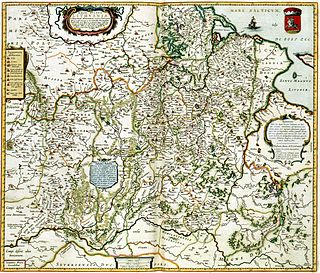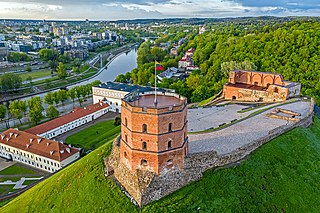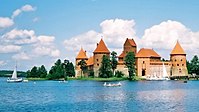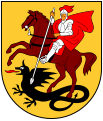
The history of Lithuania dates back to settlements founded about 10,000 years ago, but the first written record of the name for the country dates back to 1009 AD. Lithuanians, one of the Baltic peoples, later conquered neighboring lands and established the Grand Duchy of Lithuania in the 13th century. The Grand Duchy was a successful and lasting warrior state. It remained fiercely independent and was one of the last areas of Europe to adopt Christianity. A formidable power, it became the largest state in Europe in the 15th century spread from the Baltic Sea to the Black Sea, through the conquest of large groups of East Slavs who resided in Ruthenia. In 1385, the Grand Duchy formed a dynastic union with Poland through the Union of Krewo. Later, the Union of Lublin (1569) created the Polish–Lithuanian Commonwealth. During the Second Northern War, the Grand Duchy sought protection under the Swedish Empire through the Union of Kėdainiai in 1655. However, it soon returned to being a part of the Polish–Lithuanian state, which persisted until 1795 when the last of the Partitions of Poland erased both independent Lithuania and Poland from the political map. After the dissolution, Lithuanians lived under the rule of the Russian Empire until the 20th century, although there were several major rebellions, especially in 1830–1831 and 1863.

Gediminas' Tower is the remaining part of the Upper Castle on top of the Gediminas Hill in Vilnius, Lithuania.

The Grand Duchy of Lithuania was a European state that existed from the 13th century to the late 18th century, when the territory was partitioned in 1795 among the Russian Empire, the Kingdom of Prussia, and the Habsburg Empire of Austria. The state was founded by Lithuanians, who were at the time a polytheistic nation born from several united Baltic tribes from Aukštaitija.

The national emblem of Belarus features a ribbon in the colors of the national flag, a silhouette of Belarus, wheat ears and a red star. It is sometimes referred to as the coat of arms of Belarus, although in heraldic terms this is inaccurate as the emblem does not respect the rules of conventional heraldry. The emblem is an allusion to one that was used by the Byelorussian SSR, designed by Ivan Dubasov in 1950, with the biggest change being a replacement of the Communist hammer and sickle with a silhouette of Belarus. The Belarusian name is Dziaržaŭny hierb Respubliki Biełaruś, and the name in Russian is Gosudarstvennyĭ gerb Respubliki Belarusʹ.

The national flag of Lithuania consists of a horizontal tricolour of yellow, green, and red. It was adopted on 25 April 1918 during Lithuania's first period of independence from 1918 to 1940, which ceased with the occupation first by the Soviet Union, and then by Nazi Germany (1941–1944). During the post-World War II Soviet occupation, from 1945 until 1989, the Soviet Lithuanian flag consisted first of a generic red Soviet flag with the name of the republic, then changed to the red flag with white and green bands at the bottom.

The coat of arms of Lithuania is a mounted armoured knight holding a sword and shield, known as Vytis. Since the early 15th century, it has been Lithuania's official coat of arms and is one of the oldest European coats of arms. It is also known by other names in various languages, such as Waykimas, Pagaunė in the Lithuanian language or as Pogonia, Pogoń, Пагоня in the Polish, and Belarusian languages. Vytis is translatable as Chase, Pursuer, Knight or Horseman, similar to the Slavic vityaz. Historically – raitas senovės karžygys or in heraldry – raitas valdovas.

The Columns of Gediminas or Pillars of Gediminas are one of the earliest symbols of Lithuania and its historical coats of arms. They were used in the Grand Duchy of Lithuania, initially as a rulers' personal insignia, a state symbol, and later as a part of heraldic signs of leading aristocracy.

The Cathedral Basilica of St Stanislaus and St Ladislaus of Vilnius is the main Catholic cathedral in Lithuania. It is situated in Vilnius Old Town, just off Cathedral Square. Dedicated to the Christian saints Stanislaus and Ladislaus, the church is the heart of Catholic spiritual life in Lithuania.

The Catholic Church in Lithuania is part of the worldwide Catholic Church, under the spiritual leadership of the Pope in Rome. Lithuania is the world's northernmost Catholic majority country. Pope Pius XII gave Lithuania the title of "northernmost outpost of Catholicism in Europe" in 1939.
Awards and decorations of Lithuania are governed by the Republic of Lithuania Law on State Awards of 2002, amended in 2003.

The Vilnius Castle Complex is a group of cultural, and historic structures on the left bank of the Neris River, near its confluence with the Vilnia River, in Vilnius, Lithuania. The buildings, which evolved between the 10th and 18th centuries, were one of Lithuania's major defensive structures.

Antanas Žmuidzinavičius was a Lithuanian painter and art collector.
Upon the independence of Belarus from the Soviet Union, the country resurrected national symbols that were used before the Soviet era. These included a flag of red and white stripes and a coat of arms consisting of a charging knight on horseback. These national symbols were replaced by Soviet-era symbols in a disputed 1995 vote. Those two symbols, along with the national anthem, are the constitutionally defined national symbols of Belarus.

The Christianization of Lithuania occurred in 1387, initiated by King of Poland and Grand Duke of Lithuania Jogaila and his cousin Vytautas the Great. It signified the official adoption of Christianity by Lithuania, the last pagan country in Europe. This event ended one of the most complicated and lengthiest processes of Christianization in European history.
Symbols of Latvia are items or symbols that have symbolic meaning to, or represent, Latvia. These symbols are seen in official capacities, such as flags, coats of arms, postage stamps, and currency, and in URLs. They appear less formally as recurring themes in literature, art and folk art, heraldry, monuments, clothing, personal decoration, and as the names of parks, bridges, streets, and clubs. The less formal manifestations may be classified as national emblems.

The Lithuanian Crusade was a series of campaigns by the Teutonic Order and the Livonian Order under the pretext of forcibly Christianizing the pagan Grand Duchy of Lithuania. The Livonian Order occupied Riga in 1202 and in the 1230s they settled in Chełmno Land, a fief of Poland. They first conquered other neighboring Baltic tribes—Curonians, Semigallians, Latgalians, Selonians, and Old Prussians—in the Livonian Crusade and Prussian Crusade.

Kaunas Garrison Officers' Club Building is a building in Kaunas, Lithuania. At construction cost of over 1.27 million Lithuanian litas, it was one of the most luxurious buildings built in interwar Lithuania. Located next to Laisvės alėja, the main pedestrian street, the building features nationalistic symbolism and decorative folk motifs. The second of the four floors has four formal rooms of grand but eclectic design. Their interior pays homage to the Grand Duchy of Lithuania and was designed by prominent Lithuanian artists. Built in 1935–1937, the building served as the headquarters of the Officers' Club of the Lithuanian Army and venue for various official events. The building suffered great damage in the Lithuanian SSR (1945–1990). The Lithuanians recovered the building from the Russian Army in 1992 and it was taken over by the Lithuanian Armed Forces in 2000. In the early 2000s, the building underwent major renovation to restore and recreate as much of the authentic interwar decor as possible. In 2015, the building was one of 44 objects in Kaunas to receive the European Heritage Label.

The Lithuanian National Cemetery is a non-profit cemetery in Justice, Illinois, that mainly serves the Lithuanian American community in Chicago. Established in 1911, it is the resting place of many prominent Lithuanians in politics, culture, and science.

Gediminas' Cap was the most important regalia of the Lithuanian monarchs who ruled the Grand Duchy of Lithuania until the Union of Lublin in 1569. During the inaugurations of Lithuanian monarchs, Gediminas' Cap was placed on the monarch's heads by the Bishop of Vilnius in Vilnius Cathedral.









































